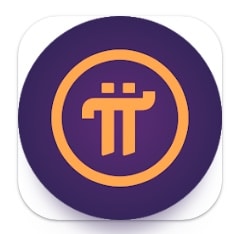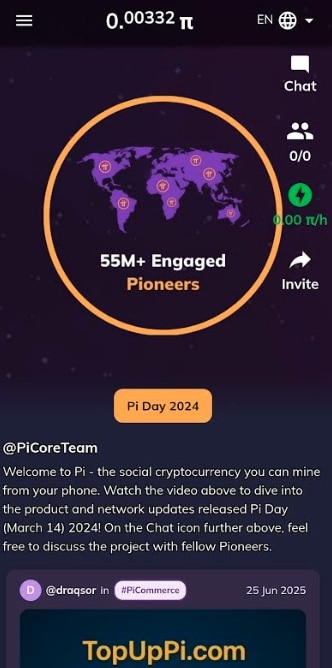Pi Network App Review: Hype and Headaches in 2025?
 Welcome to my Pi Network App Review!
Welcome to my Pi Network App Review!
Imagine earning cryptocurrency simply by tapping your phone once a day—no expensive mining rigs, no technical expertise, and no upfront costs. That’s the bold promise of Pi Network, an app that has captivated millions since its launch in 2019. Marketed as “the first digital currency you can mine on your phone,” Pi Network claims to remove the biggest barriers that keep everyday people out of crypto.
Instead of complex setups or sky-high electricity bills, Pi lets you “mine” coins with a single tap, thanks to what it calls a social consensus model. No blockchain knowledge? No problem. Anyone with a smartphone can join. This simple idea has turned Pi into one of the most viral crypto projects ever—boasting over 60 million users worldwide and a community that spans more than 230 countries.
Sounds like an opportunity too good to ignore, right? Well, before you rush to download the app, the story gets more complicated. Pi Network’s long-awaited Open Mainnet, launched in early 2025, was supposed to finally allow users to transfer, trade, and cash out their Pi coins. But as of August 2025, six months later, millions of users are still frustrated. Coins remain locked in wallets, withdrawals are restricted, and the negative feedback on platforms like Google Play is piling up. For many, what started as an exciting experiment now feels like a never-ending waiting game.
So what’s really going on with Pi Network? Is it a genuine breakthrough in crypto adoption—or just another overhyped app that keeps users engaged without delivering real value?
What Is Pi Network?
Pi Network is a mobile app developed by SocialChain Inc., a company based in the USA. It is designed to let users earn Pi Coin—a cryptocurrency created by a team of Stanford graduates—simply by checking in daily. Unlike Bitcoin, which requires high-powered computers to validate transactions and create new coins, Pi’s system relies on what it calls “social consensus.” This approach allows ordinary users to “mine” coins by tapping a button every 24 hours, proving they are real people rather than bots.
The app launched on March 14, 2019, and its founders positioned it as the most user-friendly entry point into cryptocurrency. Their goal was to build a network so inclusive that anyone with a smartphone could join and earn coins without risking money or technical headaches.
Fast forward to today, and Pi Network boasts over 60 million users across 230 countries. Since February 2025, Pi Coins have been tradeable on certain exchanges, and the platform has introduced real-world use cases through events like PiFest, where thousands of merchants worldwide accept Pi for goods and services. Pi also comes with its own wallet and a dedicated browser for apps built on its network.
But while the idea sounds great in theory, many users discover that reality involves more obstacles than expected.
How Does Pi Network Work?
Getting started with Pi Network is easy—and that’s part of its appeal. You download the app from Google Play or the App Store and sign up using either your phone number or Facebook account. The app requires verification via SMS or email to confirm your identity. This process is intended to prevent fake accounts, but it immediately raises concerns for privacy-conscious users because of the personal data involved.
After creating your account, the app prompts you to enter a referral code from an existing user. This is optional, but doing so boosts your mining speed by 25%. If you don’t have a code, you can proceed without one.
Once you complete the short tutorial, the main activity begins: tapping the green Lightning button once every 24 hours. This check-in activates your “mining session,” allowing you to earn Pi Coins at a fixed rate per hour. Typically, new users see rates ranging between 0.01 and 0.1 Pi per hour, though this depends on factors such as when you joined and whether you invite others.

Pi offers a few ways to increase your earnings beyond the daily tap. You can invite friends to join, which increases your mining speed by 25% per referral. Another option is building a security circle by adding three to five trusted users, which improves network integrity and slightly boosts your earnings.
The app also includes a chat feature for community engagement, but users frequently complain that these rooms are filled with spam and referral codes, offering little real value.
On the surface, the concept feels simple and even fun. But as many users have discovered, the process of actually using or cashing out your coins is where Pi Network becomes complicated, and for some, infuriating.
Can You Withdraw Your Pi Coins?
Technically, yes. Since Open Mainnet launched in February 2025, Pi users can transfer coins to external wallets and trade them on exchanges like OKX, Bitget, and MEXC. You can also spend Pi within its ecosystem during events like PiFest or through Pi-based apps.
But here’s the catch: before you can withdraw, you must complete the Mainnet Checklist—a long and often frustrating process that has become the single biggest pain point for Pi users.
The steps include downloading a separate app called Pi Browser, creating a secure wallet, enabling extra security settings, and most importantly, completing KYC (Know Your Customer) verification. This requires uploading a photo ID, such as a passport or driver’s license, and recording a short video to confirm your identity. The verification costs 1 Pi Coin and can take anywhere from a few days to several months, depending on Pi’s backlog.
Even after successfully passing KYC, your coins do not move immediately. They enter a transfer queue that can take weeks or even months. Some users report that their balances remain frozen for over a year. Others claim their coins were unexpectedly locked for multi-year periods—sometimes until 2028—without a clear explanation. There are also disturbing reports of coins disappearing from accounts entirely, with users unable to get help from customer support.
The numbers highlight the scope of the issue: as of August 2025, it’s estimated that only about 10.14 million users out of 60 million have completed the migration to Mainnet wallets, according to posts on X and reports from sites like AInvest.com.
That means the vast majority remain stuck in the app, unable to access the coins they’ve been “mining” for years.
Is Pi Network Trustworthy?
Pi Network’s biggest selling point is that it’s free. Unlike scams that demand upfront investment, Pi only costs time and personal data. It has an enormous global community and some real-world use cases, which gives it an air of legitimacy.Events like PiFest, where 27,000 merchants in 160 countries accepted Pi, show that the team is making efforts toward adoption.
However, the problems outweigh the positives for many users. Pi’s value has plummeted from $2.98 in February to around $0.35 in August, and with the constant creation of new coins, the price could drop even further. Locked balances, unexplained transfers, and multi-year lockup periods feel like bait-and-switch tactics.
Privacy concerns add to the unease. Pi collects names, phone numbers, emails, and ID documents, creating a significant risk if that data is ever compromised. A previous third-party data leak only adds to these fears. Users also report a surge in spam calls and texts after signing up, suggesting that their information may be shared—or worse, sold—though there’s no definitive proof.
Customer support is another sore point. Complaints about ignored tickets and unresponsive moderators are rampant, leaving users feeling abandoned. The developers’ lack of transparency about earnings calculations, coin allocation, and their revenue model raises further suspicion.
How Does Pi Network Make Money?
If users aren’t paying to mine Pi, how does the company profit? The answer lies in several channels.
First, advertising. While you can disable ads, they appear by default during mining sessions. These ads often autoplay and sometimes redirect users to external sites, generating revenue for Pi.
Second, data monetization. The app’s privacy policy allows Pi to share user information with partners. Many users believe this explains the increase in spam communications after joining.
Finally, the developers themselves hold about 20% of all Pi Coins, positioning them to make enormous profits if the currency gains value—even while users struggle to access their own coins.
Future plans also include transaction fees on Pi-based apps and services, creating yet another revenue stream for the developers.
What Are Users Saying?
Pi Network has sparked mixed reactions among its massive user base. On one hand, some enthusiastic supporters appreciate the zero-cost entry point and simplicity of the app.
They highlight that mining requires no expensive hardware and barely any effort—just tapping a button every 24 hours. Several reviewers emphasize that the app is lightweight, doesn’t drain the battery, and creates an opportunity to “get in early” on a potentially valuable cryptocurrency.
For example, one user stated: “It’s literally that simple… you have nothing to lose.” Others appreciate the project’s ambition and vision, calling Pi “a glimpse into the future of digital currency.”
However, the negative reviews overwhelmingly dominate, and they reveal some recurring pain points:
Login and Account Recovery Issues
Many users report being locked out of their accounts after years of mining. Even after following the official recovery steps, they faced error messages or were redirected to account setup pages. This has led to extreme frustration, especially for those who had mined for years:“I can’t sign in. Been trying for months now and no luck!”
KYC (Know Your Customer) Frustrations
KYC verification has been a major bottleneck. Multiple users complain about being “stuck in the queue” for months or even years despite submitting all required documents. Some even claim their coins were forfeited after the verification deadline passed:
Locked Funds and Migration Delays
While Pi has announced partial migrations to Mainnet, thousands of users still see their balances locked for years without explanation. Several reviewers call this a deliberate strategy to keep users engaged without delivering liquidity:
Security Concerns and Lost Tokens
Alarmingly, multiple users report mysterious transfers of their Pi to unknown wallets—even when they never shared their passphrase. This raises concerns about vulnerabilities.
“Never leaked my passphrase, yet my tokens were gone. Support never replied.”
Poor Customer Support
Across hundreds of reviews, one recurring complaint is the absence of effective support. Users describe sending countless emails or tickets, only to receive automated responses or no reply at all:
Ads and UX Problems
Several reviews note that ads have become intrusive, sometimes even opening external apps or hijacking the browser. Others complain about bugs during mining sessions, delayed notifications, and crashes during wallet creation or verification.
Doubts About Liquidity and Value
Some long-term users voice skepticism about Pi’s economic viability:
“It takes over a month to get one coin worth about £0.50, and then it’s locked for 3 years.”
Others fear Pi has shifted from a legitimate crypto experiment to a data-harvesting scheme, citing increased ads and personal data collection requirements.
That said, a minority of optimistic reviews remain, focusing on Pi as a long-term bet:
“Worst case, I wasted a few seconds a day. Best case, I’m eating crypto-lobster on the beach.”
Conclusion
Pi Network started as an exciting experiment to democratize crypto mining, and it still boasts a massive global user base—a sign of strong community interest. The app’s simplicity and zero-cost entry have always been its most significant selling points.
However, after years of development, Pi faces serious trust issues. Users are frustrated by locked funds, indefinite migrations, KYC failures, account recovery problems, and zero transparency from the Core Team. Reports of lost coins and lack of support further damage its credibility.
While Pi Network claims to be building a decentralized future, the reality today feels far from that promise.
If you’re considering joining, understand this: it’s free to mine, but your time and data may be the real cost. There’s no guarantee Pi will ever achieve open trading or significant value. For now, it remains a speculative gamble—one that many early adopters are starting to regret.





